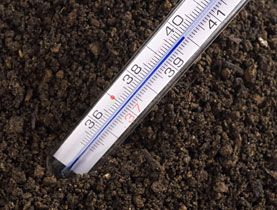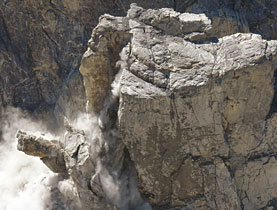Glaciers continue to disappear

Eighty-two of 88 glaciers measured in Switzerland between 2007 and 2008 reduced in length, according to scientists at the Federal Institute of Technology in Zurich.
Although the winter of 2007 was one of the snowiest ever – with many stations reporting record snowfalls – this was cancelled out by a hot summer. The Gorner Glacier alone shrank by 290 metres.
“The measurements confirm once again the ongoing glacial retreat observed over recent years,” Andreas Bauder, a glaciologist at the institute, told swissinfo.
Bauder, who took part in the study, explained the two types of measurements: length change and mass balance.
“We investigated the latest measurements for mass balance – in which one looks at the difference between the accumulation of snow and the melting of the ice – and it more or less reflects the average value of the past ten years,” he said.
“Length-change information represents the mid- to long term, although it depends on the glacier’s size and other factors.”
For example, whereas only two glaciers got longer and most shrank by less than 25 metres, the Gorner Glacier, a valley glacier found on the Monte Rosa massif close to Zermatt in western Switzerland, withered by 290 metres.
“The snout [of the Gorner Glacier] was located for a couple of years in a narrow shaded gorge where there wasn’t much change,” Bauder explained.
“The back of the glacier melted more and a hole appeared. Now this remaining ice in the gorge has melted. But in principle this figure represents a trend of the past five to ten years.”
Global warming
The main cause of the melting between 2007 and 2008 was the unusually warm May and June in 2008, according to the study, which was released by the by the Swiss Academy of Sciences.
This resulted in the winter’s snow – which had fallen in above-average quantities – melting rapidly, directly exposing the glacier to the sun in the summer.
No figures existed for winter 2008, Bauder said, adding that it was still winter for glaciers, which don’t reach their maximum mass until the end of April or beginning of May.
He also confirmed the direct connection between global warming and glacier shrinkage.
“It depends on individual glaciers and their history and how fast the dynamics of the glacier will be affected, but it’s the climate system which drives the glacier dynamic,” he said.
Temperatures have been taken on the 4,452m firn saddle of Colle Gnifetti – in the highest part of Grenz- and Gorner Glacier – since 1982.
The latest readings, taken at a depth of 20 metres, show temperatures rose by 0.5 degree Celsius between 1982 and 2000 and by 1.2 degrees between 2000 and 2008.
Consequences
And it is not just tourists who are lamenting the disappearance of Switzerland’s glaciers.
“Glaciers are an important component in the hydrological cycle and store water,” Bauder said. “During hot dry summers the melting from these reservoirs can balance or reduce any shortcomings in water availability.”
In Switzerland glaciers also play an important role as water reservoirs for hydro-power production, generating 50 per cent of the country’s electricity.
Bauder says reversing the shrinking Alpine glaciers is a formidable challenge.
“The problem is that the driving force for the glacier system is the climate and if we want to change the glacier retreat then we have to change the climate – it’s a global issue.”
swissinfo, Thomas Stephens
Temperatures in Switzerland have risen by an average of 0.57 degrees Celsius each decade since 1970. The increase is twice the average for the northern hemisphere.
Carbon dioxide is one of the major gases responsible for the greenhouse effect and global warming. In Switzerland it represents around 80% of harmful emissions. Other gases include methane, nitrous oxide and hydrocarbons.
Despite ambitious emission targets, greenhouse gas emissions have actually risen by 0.4% in Switzerland since 1990.
Glaciers are large masses of snow, ice and rock debris that accumulate in great quantities and begin to flow outwards and downwards under the pressure of their own weight.
They are formed when yearly snowfall in a region far exceeds the amount of snow and ice that melts in a given summer.
In Switzerland, glaciers play an important role as water reservoirs for hydro-power production (generating 50% of the country’s electricity). They are also considered an important tourist attraction.
Switzerland’s glaciers lost 18% of their surface between 1985 and 2000. In the Alps, the average loss has been 22%. Swiss glaciers are melting more slowly because most of them are at high altitude.
Meltdown affects smaller glaciers – which represent 18% of total glacier surface but nearly half the losses incurred – first, according to a 2004 study from Zurich University.

In compliance with the JTI standards
More: SWI swissinfo.ch certified by the Journalism Trust Initiative













You can find an overview of ongoing debates with our journalists here . Please join us!
If you want to start a conversation about a topic raised in this article or want to report factual errors, email us at english@swissinfo.ch.